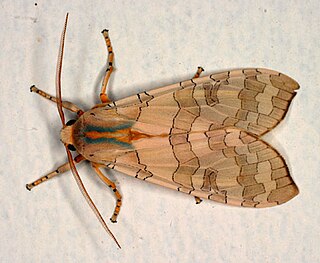
Lepidoptera is an order of insects that includes butterflies and moths. About 180,000 species of the Lepidoptera are described, in 126 families and 46 superfamilies, 10 per cent of the total described species of living organisms. It is one of the most widespread and widely recognizable insect orders in the world. The Lepidoptera show many variations of the basic body structure that have evolved to gain advantages in lifestyle and distribution. Recent estimates suggest the order may have more species than earlier thought, and is among the four most speciose orders, along with the Hymenoptera, Diptera, and Coleoptera.

The Noctuidae, commonly known as owlet moths, cutworms or armyworms, are the most controversial family in the superfamily Noctuoidea because many of the clades are constantly changing, along with the other families of the Noctuoidea. It was considered the largest family in Lepidoptera for a long time, but after regrouping Lymantriinae, Catocalinae and Calpinae within the family Erebidae, the latter holds this title now. Currently, Noctuidae is the second largest family in Noctuoidea, with about 1,089 genera and 11,772 species. However, this classification is still contingent, as more changes continue to appear between Noctuidae and Erebidae.

The Arctiinae are a large and diverse subfamily of moths, with around 11,000 species found all over the world, including 6,000 neotropical species. This group includes the groups commonly known as tiger moths, which usually have bright colours, footmen, which are usually much drabber, lichen moths, and wasp moths. Many species have "hairy" caterpillars that are popularly known as woolly bears or woolly worms. The scientific name of this subfamily refers to this hairiness. Some species within the Arctiinae have the word tussock in their common name due to people misidentifying them as members of the Lymantriinae based on the characteristics of the larvae.

The Ditrysia are a natural group or clade of insects in the lepidopteran order containing both butterflies and moths. They are so named because the female has two distinct sexual openings: one for mating, and the other for laying eggs.

Arthur Gardiner Butler F.L.S., F.Z.S. (1844–1925) was an English entomologist, arachnologist and ornithologist. He worked at the British Museum on the taxonomy of birds, insects, and spiders.

Amphiesmenoptera is an insect superorder, established by S. G. Kiriakoff, but often credited to Willi Hennig in his revision of insect taxonomy for two sister orders: Lepidoptera and Trichoptera (caddisflies). In 2017, a third fossil order was added to the group, the Tarachoptera.

The Phaegopterina are a subtribe of tiger moths in the tribe Arctiini, which is part of the family Erebidae. The subtribe was described by William Forsell Kirby in 1892.

Neonerita is a genus of moths in the family Erebidae. The genus was erected by George Hampson in 1901.
The Global Lepidoptera Names Index (LepIndex) is a searchable database maintained by the Department of Entomology at the Natural History Museum, London.
Pseudepimolis ridenda is a moth of the family Erebidae first described by Paul Dognin in 1911. It is found in French Guiana and Brazil.

Epimolis incarnata is a moth of the family Erebidae. It was described by George Hampson in 1901. It is found in French Guiana, Brazil, Ecuador and Peru.

Pseudepimolis incisa is a moth of the family Erebidae. It was described by Walter Rothschild in 1909. It is found in Costa Rica, French Guiana, Brazil, the upper Amazon region, Venezuela and Bolivia.
Pseudepimolis marpessa is a moth of the family Erebidae. It was described by Herbert Druce in 1906. It is found in Peru.
Epimolis pseudopraemolis is a moth of the family Erebidae. It was described by Walter Rothschild in 1909. It is found in Peru.
Epimolis syrissa is a moth of the family Erebidae. It was described by Herbert Druce in 1906. It is found in Peru.
Pseudepimolis rhyssa is a moth in the family Erebidae first described by Herbert Druce in 1906. It is found in Peru.
Pseudepimolis apiciplaga is a moth in the family Erebidae. It was described by Walter Rothschild in 1909. It is found in Brazil.
Pseudepimolis is a genus of moths in the family Erebidae. It was erected by Benoît Vincent and Michel Laguerre in 2013.

Eulepidoptera is a division of lepidopterans in the infraorder Heteroneura.








